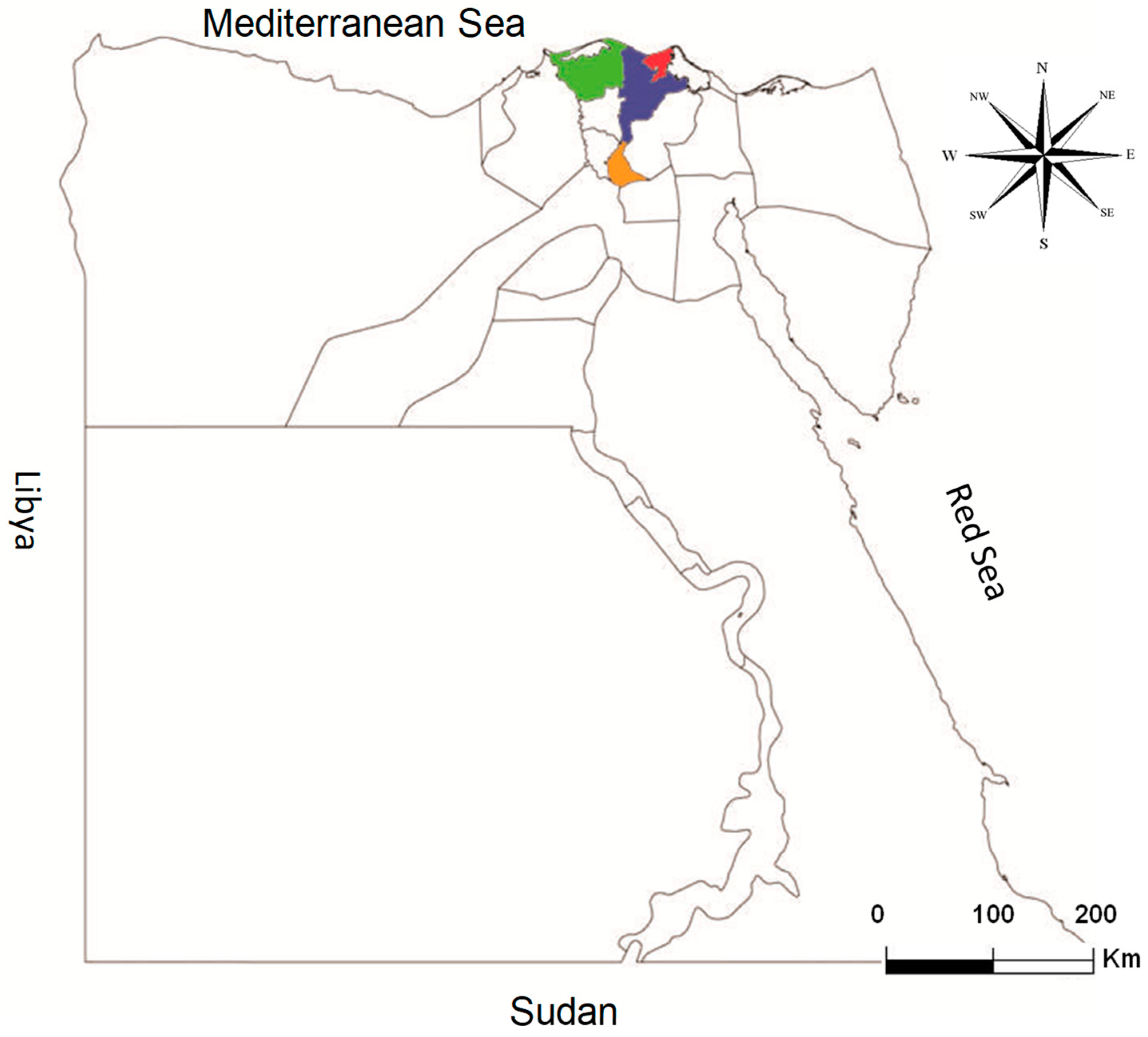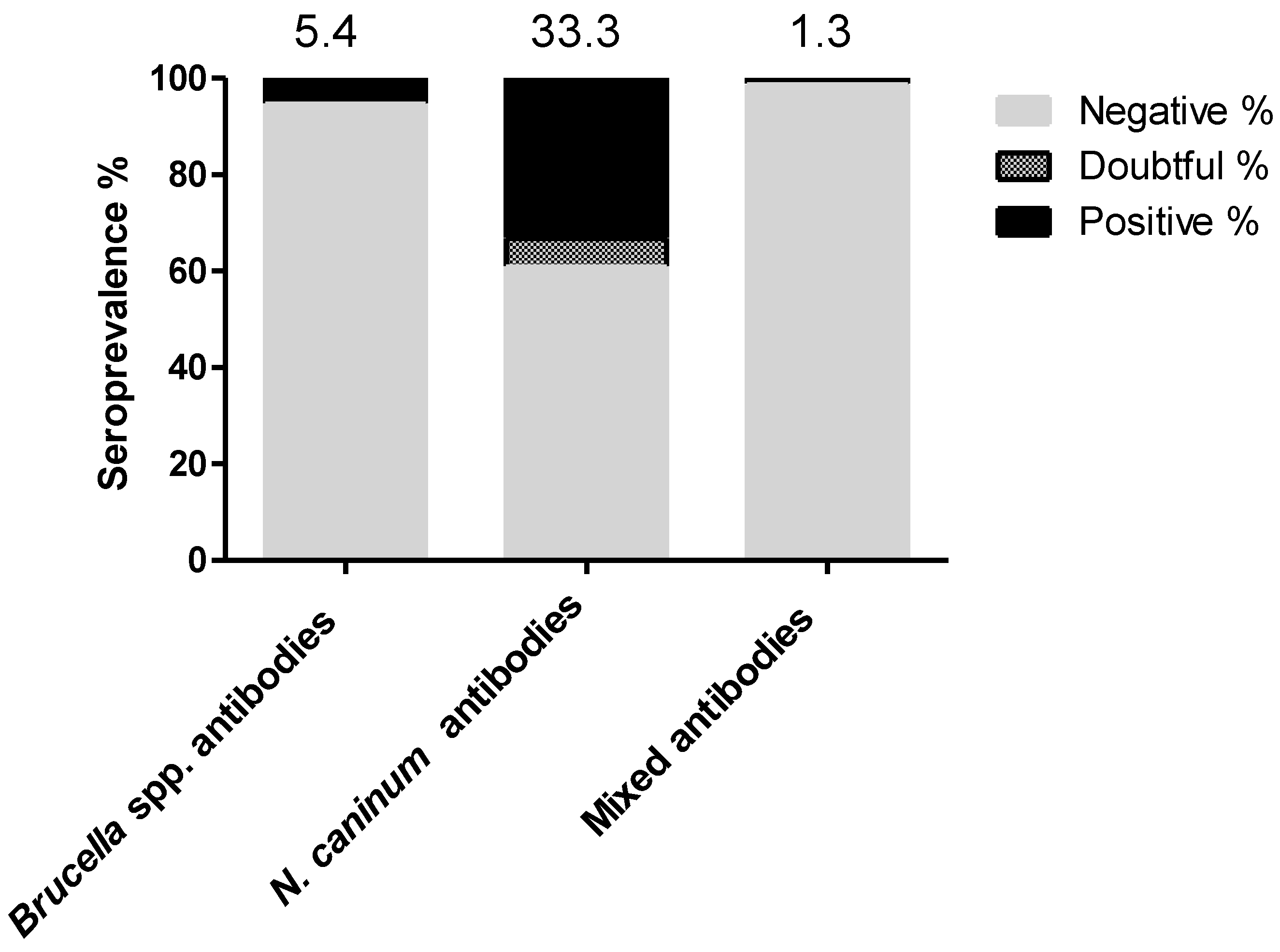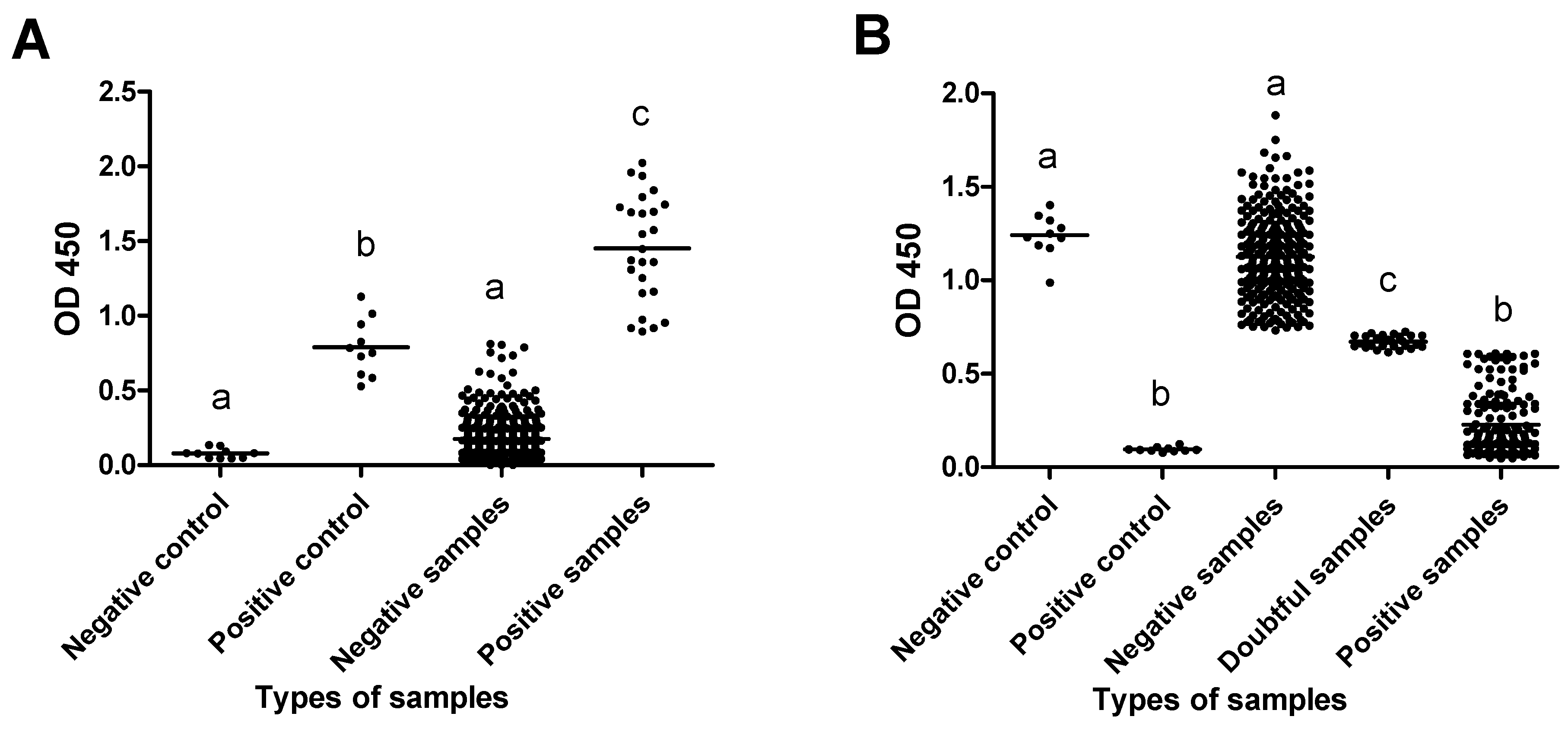Seroprevalence of Antibodies to Brucella spp. and Neospora caninum in Cattle from Delta Region of Egypt: Correlation of Seropositivity with Abortion History
Abstract
1. Introduction
2. Materials and Methods
2.1. Ethical Approval
2.2. Description of the Animals and Regions in This Study
2.3. Serological Diagnosis of Brucella Species and Neospora caninum
2.4. Statistical Analysis
3. Results
3.1. Seroprevalence Rates and Risk Factors of Brucella Species and Neospora caninum Antibodies in Tested Cows
3.2. Dynamicity of Antibody Levels and Relationship with Abortion History in Tested Cows
4. Discussion
5. Conclusions
Author Contributions
Funding
Institutional Review Board Statement
Informed Consent Statement
Data Availability Statement
Acknowledgments
Conflicts of Interest
References
- Fereig, R.M.; Wareth, G.; Abdelbaky, H.H.; Mazeed, A.M.; El-Diasty, M.; Abdelkhalek, A.; Mahmoud, H.Y.; Ali, A.O.; El-Tayeb, A.; Alsayeqh, A.F.; et al. Seroprevalence of specific antibodies to Toxoplasma gondii, Neospora caninum, and Brucella spp. in sheep and goats in Egypt. Animals 2022, 12, 3327. [Google Scholar] [CrossRef] [PubMed]
- Nayeri, T.; Moosazadeh, M.; Sarvi, S.; Daryani, A. Neospora caninum infection in aborting bovines and lost fetuses: A systematic review and meta-analysis. PLoS ONE 2022, 17, e0268903. [Google Scholar] [CrossRef] [PubMed]
- Ntivuguruzwa, J.B.; Kolo, F.B.; Mwikarago, E.I.; Van Heerden, H. Characterization of Brucella spp. and other abortigenic pathogens from aborted tissues of cattle and goats in Rwanda. Vet. Med. Sci. 2022, 8, 1655–1663. [Google Scholar] [CrossRef]
- Yang, J.; Wang, Y.; Hou, Y.; Sun, M.; Xia, T.; Wu, X. Evasion of host defense by Brucella. Cell Insight 2023, 3, 100143. [Google Scholar] [CrossRef]
- Alamian, S.; Amiry, K.; Bahreinipour, A.; Etemadi, A.; Tebianian, M.; Mehrabadi, M.H.F.; Dadar, M. Brucella species circulating in rural and periurban dairy cattle farms: A comparative study in an endemic area. Trop. Anim. Health Prod. 2021, 53, 200. [Google Scholar] [CrossRef] [PubMed]
- Mitiku, W.; Desa, G. Review of bovine brucellosis and its public health significance. Healthcare Rev. 2020, 1, 16–33. [Google Scholar] [CrossRef]
- Hosein, H.I.; Hamdy, M.E.; Zaitoun, A.; Menshawy, A.M.; Rouby, S.R.; Madkour, B.; Mazeed, A.M.; Abdel-Ra’ouf, A. Brucella Prevalent Strains Circulating in Egypt during 2020-2021: Bacteriological and Molecular Study. J. Vet. Med. Res. 2021, 28, 12–20. [Google Scholar] [CrossRef]
- Dubey, J.P.; Lindsay, D.S. A review of Neospora caninum and neosporosis. Vet. Parasitol. 1996, 67, 1–59. [Google Scholar] [CrossRef]
- VanLeeuwen, J.; Muraya, J.; Gitau, G.; Makau, D.; Crane, B.; McKenna, S.; Wichtel, J. Seroprevalence and risk factors of Neospora caninum and Bovine Viral Diarrhoea Virus in smallholder dairy cattle in Kenya. East Afr. J. Sci. Technol. Innov. 2021, 3, 2021. [Google Scholar] [CrossRef]
- Waap, H.; Bärwald, A.; Nunes, T.; Schares, G. Seroprevalence and Risk Factors for Toxoplasma gondii and Neospora caninum in Cattle in Portugal. Animals 2022, 12, 2080. [Google Scholar] [CrossRef]
- Tranas, J.; Heinzen, R.A.; Weiss, L.M.; McAllister, M.M. Serological evidence of human infection with the protozoan Neospora caninum. Clin. Diagn. Lab. Immunol. 1999, 6, 765–767. [Google Scholar] [CrossRef] [PubMed]
- Duarte, P.O.; Csordas, B.G.; Oshiro, L.M.; Higa, L.d.O.S.; Zimmermann, N.P.; Martins, K.R.; Barros, J.C.; Andreotti, R. Serological evaluation of Neospora caninum in pregnant women treated at referral center for prenatal screening in Mato Grosso do Sul, Brazil. Rev. Bras. Parasitol. Vet. 2020, 29, e010820. [Google Scholar] [CrossRef]
- Duarte, P.O.; Oshiro, L.M.; Zimmermann, N.P.; Csordas, B.G.; Dourado, D.M.; Barros, J.C.; Andreotti, R. Serological and molecular detection of Neospora caninum and Toxoplasma gondii in human umbilical cord blood and placental tissue samples. Sci. Rep. 2020, 10, 9043. [Google Scholar] [CrossRef] [PubMed]
- Wareth, G.; Hikal, A.; Refai, M.; Melzer, F.; Roesler, U.; Neubauer, H. Animal brucellosis in Egypt. J. Infect. Dev. Ctries. 2014, 8, 1365–1373. [Google Scholar] [CrossRef]
- Selim, A.; Attia, K.; Ramadan, E.; Hafez, Y.M.; Salman, A. Seroprevalence and molecular characterization of Brucella species in naturally infected cattle and sheep. Prev. Vet. Med. 2019, 171, 104756. [Google Scholar] [CrossRef]
- Selim, A.; Alshammari, A.; Gattan, H.S.; Marzok, M.; Salem, M.; Al-Jabr, O.A. Neospora caninum infection in dairy cattle in Egypt: A serosurvey and associated risk factors. Sci. Rep. 2023, 13, 15489. [Google Scholar] [CrossRef]
- Ran, X.; Cheng, J.; Wang, M.; Chen, X.; Wang, H.; Ge, Y.; Ni, H.; Zhang, X.X.; Wen, X. Brucellosis seroprevalence in dairy cattle in China during 2008–2018: A systematic review and meta-analysis. Acta Trop. 2019, 189, 117–123. [Google Scholar] [CrossRef] [PubMed]
- El-Diasty, M.; Salah, K.; El-Hofy, F.I.; Abd El Tawab, A.A.; Soliman, E.A. Investigation of an outbreak of brucellosis in a mixed dairy farm and evaluation of a test and slaughter strategy to release the herd out of the quarantine. Ger. J. Vet. Res. 2022, 2, 1–9. [Google Scholar] [CrossRef]
- Metwally, S.; Hamada, R.; Sobhy, K.; Frey, C.F.; Fereig, R.M. Seroprevalence and risk factors analysis of Neospora caninum and Toxoplasma gondii in cattle of Beheira, Egypt. Front. Vet. Sci. 2023, 10, 1122092. [Google Scholar] [CrossRef]
- Farag, S.I.; Cano-Terriza, D.; Gonzálvez, M.; Salman, D.; Aref, N.-E.M.; Mubaraki, M.A.; Jiménez-Martín, D.; García-Bocanegra, I.; Elmahallawy, E.K. Serosurvey of selected reproductive pathogens in domestic ruminants from Upper Egypt. Front. Vet. Sci. 2023, 10, 1267640. [Google Scholar] [CrossRef]
- Samaha, H.; Al-Rowaily, M.; Khoudair, R.M.; Ashour, H.M. Multicenter study of brucellosis in Egypt. Emerg. Infect. Dis. 2008, 14, 1916–1918. [Google Scholar] [CrossRef] [PubMed]
- Akinyemi, K.O.; Ajoseh, S.O.; Anjorin, A.; Salami, W.S.; Lawal, A.O.; Bassiouny, M.; Neubauer, H.; Wareth, G. A systematic scoping review of microbial pathogens in ruminants with or without a history of abortions in Nigeria. Ger. J. Vet. Res. 2023, 3, 34–51. [Google Scholar] [CrossRef]
- Ibrahim, A.K.; AbdelAll, A.A.; Amin, A.S. Long-term diagnostic studies for detection of Brucella spp. in milk samples. Glob. Vet. 2012, 8, 54–61. [Google Scholar]
- Amin, M.; Ahmed, S.; Zaki, H.; Ismail, R. Serological and molecular studies on the diagnosis of bovine brucellosis. Nat. Sci. 2012, 10, 68–76. [Google Scholar]
- Hegazy, Y.M.; Molina-Flores, B.; Shafik, H.; Ridler, A.L.; Guitian, F.J. Ruminant brucellosis in Upper Egypt (2005–2008). Prev. Vet. Med. 2011, 101, 173–181. [Google Scholar] [CrossRef] [PubMed]
- Kaoud, H.; Zaki, M.; El-Dahshan, A.; Nasr, S. Epidemiology of brucellosis among farm animals. Nat. Sci. 2010, 8, 190–197. [Google Scholar]
- Musallam, I.I.; Abo-Shehada, M.N.; Hegazy, Y.M.; Holt, H.R.; Guitian, F.J. Systematic review of brucellosis in the Middle East: Disease frequency in ruminants and humans and risk factors for human infection. Epidemiol. Infect. 2016, 144, 671–685. [Google Scholar] [CrossRef]
- Gerges, A.A.; Mona, S.; Fathi, A.; Mohamed, H.; Abou-gazia, K.H.A.; Mohamed, H.F. Detection of Neospora caninum and Coxiella burnetii antibodies in milk and serum of infected dairy cattle. Assiut Vet. Med. J. 2018, 64, 49–57. [Google Scholar]
- El-Mohamady, R.S.; Gerges, A.M.; Abd-Elhafeiz, Y.G.M. Investigation of the association between bovine viral diarrhea virus and Neospora caninum as a cause of abortion in cattle. J. Applied Vet. Sci. 2022, 7, 11–17. [Google Scholar] [CrossRef]
- Ibrahim, H.M.; Huang, P.; Salem, T.A.; Talaat, R.M.; Nasr, M.I.; Xuan, X.; Nishikawa, Y. Prevalence of Neospora caninum and Toxoplasma gondii antibodies in Northern Egypt. Am. J. Trop. Med. Hyg. 2009, 80, 263–267. [Google Scholar] [CrossRef]
- Ibrahim, H.M.; Abdel-Rahman, A.A.; Bishr, N.M. Seroprevalence of Neospora caninum and Toxoplasma gondii IgG and IgM antibodies among buffaloes and cattle from Menoufia Province, Egypt. J. Parasit. Dis. 2021, 45, 952–958. [Google Scholar] [CrossRef] [PubMed]
- Fereig, R.M.; AbouLaila, M.R.; Mohamed, S.G.; Mahmoud, H.Y.; Ali, A.O.; Ali, A.F.; Hilali, M.; Zaid, A.; Mohamed, A.E.A.; Nishikawa, Y. Serological detection and epidemiology of Neospora caninum and Cryptosporidium parvum antibodies in cattle in southern Egypt. Acta Trop. 2016, 162, 206–211. [Google Scholar] [CrossRef] [PubMed]
- Dubey, J.P.; Romand, S.; Hilali, M.; Kwok, O.C.H.; Thulliez, P. Seroprevalence of antibodies to Neospora caninum and Toxoplasma gondii in water buffaloes (Bubalus bubalis) from Egypt. Int. J. Parasitol. 1998, 28, 527–529. [Google Scholar] [CrossRef] [PubMed]
- El-Diasty, M.; El-Said, R.; Abdelkhalek, A. Seroprevalence and molecular diagnosis of sheep brucellosis in Dakahlia governorate, Egypt. Ger. J. Vet. Res. 2021, 1, 34–39. [Google Scholar] [CrossRef]
- Selim, A.; Abdelhady, A. Neosporosis among Egyptian camels and its associated risk factors. Trop. Anim. Health Prod. 2020, 52, 3381–3385. [Google Scholar] [CrossRef]
- Abdelbaky, H.H.; Nishimura, M.; Shimoda, N.; Hiasa, J.; Fereig, R.M.; Tokimitsu, H.; Inokuma, H.; Nishikawa, Y. Evaluation of Neospora caninum serodiagnostic antigens for bovine neosporosis. Parasitol Int. 2020, 75, 102045. [Google Scholar] [CrossRef]





| Governorate | Abortion History * | Total | ||
|---|---|---|---|---|
| Yes | No | Unknown | ||
| Kafr El Sheikh | 26 | 0 | 0 | 26 |
| Dakahlia | 11 | 33 | 246 | 290 |
| Al-Qalyubia | 0 | 0 | 93 | 93 |
| Damietta | 0 | 51 | 0 | 51 |
| Total | 37 | 84 | 339 | 460 |
| Analyzed Factor | No. of Tested | No. of Negative (%; 95% CI) | No. of Positive (%; 95% CI) | OR (95% CI) * | p-Value * |
|---|---|---|---|---|---|
| Governorate | |||||
| Kafr El Sheikh | 26 | 11 (42.3; 24–62.8) | 15 (57.7; 37.2–76) | 125.5(15.1–1044) | <0.0001 |
| Dakahlia | 290 | 284 (97.9; 95.4–99.2) | 6 (2.1; 0.8–4.7) | 1.9 (0.2–16.4) | 1.000 |
| Al-Qalyubia | 93 | 92 (98.9; 93.3–99.9) | 1 (1.1; 0.1–6.7) | Ref | Ref |
| Damietta | 51 | 48 (94.1; 82.8–98.5) | 3 (5.9; 1.5–17.2) | 5.7 (0.6–56.8) | 0.127 |
| Total | 460 | 435 (94.6; 92–96.4) | 25 (5.4; 3.6–8) | - | - |
| Abortion history | |||||
| Yes | 37 | 17 (45.9; 29.9–62.9) | 20 (54.1; 37.1–70.1) | 198.2 (42.8–918.6) | <0.0001 |
| No | 84 | 81 (96.4; 89.2–99.1) | 3 (3.6; 0.9–10.8) | 6.2 (1–38) | 0.055 |
| Unknown | 339 | 337 (99.4; 97.7–99.9) | 2 (0.6; 0.1–2.4) | Ref | Ref |
| Total | 460 | 435 (94.6; 92–96.4) | 25 (5.4; 3.6–8) | - | - |
| Analyzed Factor | No. of Tested | No. of Negative (%; 95% CI) | No. of Positive (%; 95% CI) | OR (95% CI) * | p-Value * |
|---|---|---|---|---|---|
| Governorate | |||||
| Kafr El Sheikh | 26 | 23 (88.5; 68.7–97) | 3 (11.5; 3–31.3) | Ref | Ref |
| Dakahlia | 290 | 193 (66.6; 60.8–72) | 97(33.4; 28.1–39.2) | 3.8 (1.1–13.2) | 0.026 |
| Al-Qalyubia | 93 | 66 (71; 60.5–79.7) | 27 (29; 20.3–39.5) | 3.1 (0.9–11.3) | 0.079 |
| Damietta | 51 | 25 (49; 34.9–63.2) | 26 (51; 36.8–65.1) | 8 (2.1–29.9) | 0.001 |
| Total | 460 | 307 (66.7; 62.2–71) | 153 (33.3; 29–37.8) | - | - |
| Abortion history | |||||
| Yes | 37 | 29 (78.4; 61.3–89.6) | 8 (21.6; 10.4–38.7) | Ref | Ref |
| No | 84 | 44 (52.4; 41.3–63.3) | 40 (47.6; 36.7–58.7) | 3.3 (1.3–8) | 0.009 |
| Unknown | 339 | 234 (69; 63.8–73.9) | 105 (31; 26.1–36.3) | 1.6 (0.7–3.7) | 0.264 |
| Total | 460 | 307 (66.7; 62.2–71) | 153 (33.3; 29–37.8) | - | - |
Disclaimer/Publisher’s Note: The statements, opinions and data contained in all publications are solely those of the individual author(s) and contributor(s) and not of MDPI and/or the editor(s). MDPI and/or the editor(s) disclaim responsibility for any injury to people or property resulting from any ideas, methods, instructions or products referred to in the content. |
© 2024 by the authors. Licensee MDPI, Basel, Switzerland. This article is an open access article distributed under the terms and conditions of the Creative Commons Attribution (CC BY) license (https://creativecommons.org/licenses/by/4.0/).
Share and Cite
Fereig, R.M.; Mazeed, A.M.; Alharbi, A.S.; Abdelraheem, M.Z.; Omar, M.A.; Almuzaini, A.M.; El-Diasty, M.; Elsharkawy, H.I.; Sobhy, K.; Frey, C.F.; et al. Seroprevalence of Antibodies to Brucella spp. and Neospora caninum in Cattle from Delta Region of Egypt: Correlation of Seropositivity with Abortion History. Immuno 2024, 4, 374-384. https://doi.org/10.3390/immuno4040024
Fereig RM, Mazeed AM, Alharbi AS, Abdelraheem MZ, Omar MA, Almuzaini AM, El-Diasty M, Elsharkawy HI, Sobhy K, Frey CF, et al. Seroprevalence of Antibodies to Brucella spp. and Neospora caninum in Cattle from Delta Region of Egypt: Correlation of Seropositivity with Abortion History. Immuno. 2024; 4(4):374-384. https://doi.org/10.3390/immuno4040024
Chicago/Turabian StyleFereig, Ragab M., Amira M. Mazeed, Azzah S. Alharbi, Mona Z. Abdelraheem, Mosaab A. Omar, Abdulaziz M. Almuzaini, Mohamed El-Diasty, Hend I. Elsharkawy, Kamel Sobhy, Caroline F. Frey, and et al. 2024. "Seroprevalence of Antibodies to Brucella spp. and Neospora caninum in Cattle from Delta Region of Egypt: Correlation of Seropositivity with Abortion History" Immuno 4, no. 4: 374-384. https://doi.org/10.3390/immuno4040024
APA StyleFereig, R. M., Mazeed, A. M., Alharbi, A. S., Abdelraheem, M. Z., Omar, M. A., Almuzaini, A. M., El-Diasty, M., Elsharkawy, H. I., Sobhy, K., Frey, C. F., & Wareth, G. (2024). Seroprevalence of Antibodies to Brucella spp. and Neospora caninum in Cattle from Delta Region of Egypt: Correlation of Seropositivity with Abortion History. Immuno, 4(4), 374-384. https://doi.org/10.3390/immuno4040024







